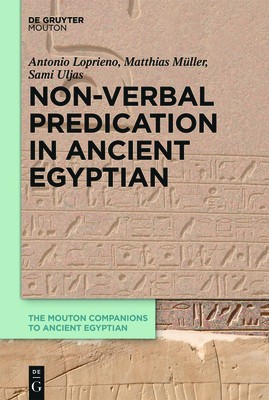
- We will send in 10–14 business days.
- Author: Antonio Loprieno
- Publisher: Walter de Gruyter
- Year: 2017
- Pages: 859
- ISBN-10: 311040611X
- ISBN-13: 9783110406115
- Format: 16.5 x 23.4 x 5.1 cm, kieti viršeliai
- Language: English
- SAVE -10% with code: EXTRA
Reviews
Description
The Egyptian language, with its written documentation spreading from the Early Bronze Age (Ancient Egyptian) to Christian times (Coptic), has rarely been the object of typological studies, grammatical analysis mainly serving philological purposes.
This volume offers now a detailed analysis and a diachronic discussion of the non-verbal patterns of the Egyptian language, from the Pyramid Texts (Earlier Egyptian) to Coptic (Later Egyptian), based on an extensive use of data, especially for later phases. By providing a narrative contextualisation and a linguistic glossing of all examples, it addresses the needs not only of students of Egyptian and Coptic, but also of a linguistic readership. After an introduction into the basic typological features of Egyptian, the main book chapters address morphology, syntax, semantics and pragmatics of the three non-verbal sentence types documented throughout the history of this language: the adverbial sentence, the nominal sentence and the adjectival sentence. These patterns also appear in a variety of clausal environments and can be embedded in verbal constructions.
This book provides an ideal introduction into the study of Egyptian historical grammar and an indispensable companion for philological reading.
EXTRA 10 % discount with code: EXTRA
The promotion ends in 21d.16:23:10
The discount code is valid when purchasing from 10 €. Discounts do not stack.
- Author: Antonio Loprieno
- Publisher: Walter de Gruyter
- Year: 2017
- Pages: 859
- ISBN-10: 311040611X
- ISBN-13: 9783110406115
- Format: 16.5 x 23.4 x 5.1 cm, kieti viršeliai
- Language: English English
The Egyptian language, with its written documentation spreading from the Early Bronze Age (Ancient Egyptian) to Christian times (Coptic), has rarely been the object of typological studies, grammatical analysis mainly serving philological purposes.
This volume offers now a detailed analysis and a diachronic discussion of the non-verbal patterns of the Egyptian language, from the Pyramid Texts (Earlier Egyptian) to Coptic (Later Egyptian), based on an extensive use of data, especially for later phases. By providing a narrative contextualisation and a linguistic glossing of all examples, it addresses the needs not only of students of Egyptian and Coptic, but also of a linguistic readership. After an introduction into the basic typological features of Egyptian, the main book chapters address morphology, syntax, semantics and pragmatics of the three non-verbal sentence types documented throughout the history of this language: the adverbial sentence, the nominal sentence and the adjectival sentence. These patterns also appear in a variety of clausal environments and can be embedded in verbal constructions.
This book provides an ideal introduction into the study of Egyptian historical grammar and an indispensable companion for philological reading.


Reviews